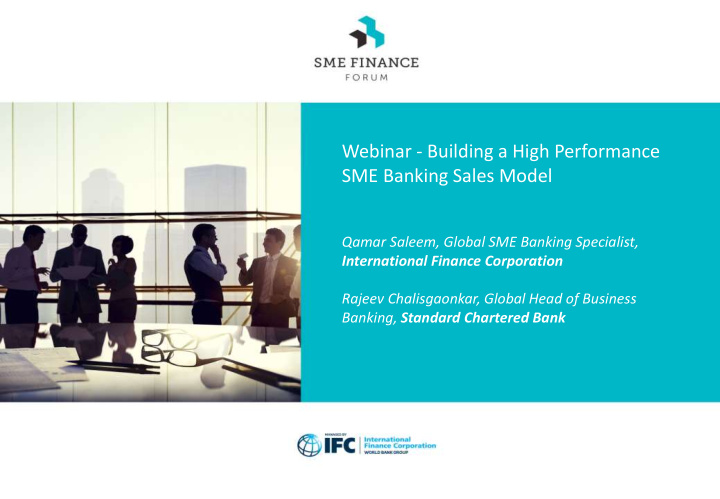



Webinar - Building a High Performance SME Banking Sales Model Qamar Saleem, Global SME Banking Specialist, International Finance Corporation Rajeev Chalisgaonkar, Global Head of Business Banking, Standard Chartered Bank
Building a High Performance SME Banking Sales Model Rajeev Chalisgaonkar Global Head, Business Banking Standard Chartered Bank 1
The Strategic Context Much depends on the context of your bank Large incumbent banks with a significant network Growing local or international bank wishing to acquire market share 2
Why SME Banking Significant contributors to GDP and employment Strong push by Governments and regulators Under-served in most markets Significant linkages between the business and personal banking wallets of entrepreneurs Opportunity for higher risk-adjusted profitability 3
Coverage Models 4
Choice #1: Where should SME Banking be Part of Retail Banking Unit within Corporate or Commercial Banking Independent unit reporting into the CEO 5
Choice #1: Where should SME Banking be Retail Commercial Easier to adopt mass- Greater comfort with lending techniques complex needs Clients benefit from the Lower comfort with network scorecard lending Easier to link business Higher unit costs and personal Easier to exploit supply Product set tends to be chains basic, often adopted from Requires alignment with Retail products branch network for Limited comfort with servicing complex client needs 6
Choice #2: Sales Model Walk-in acquisition and reactive servicing Hunter & Farmer Finder is keeper Common RM across personal and business 7
Choice #2: Sales Model Hunter & Farmer Finder is Keeper Common RM Most prevalent Market research Quicker market share amongst SME banks inconclusive Better focus on Higher quality of new Easier to implement acquisition clients for smaller clients Higher Acquisition Lower productivity Organisation above productivity RM needs to be Better client Client relationship aligned too experience quality can be lower Product and pricing RMs too busy to Client experience issues needs to be joined up acquire new clients Farmers free to focus on Dual skilled RMs client engagement Opportunity cost Client referrals under- utilised 8
Choice #3: Digital v Personal Sales SMEs frequently using Internet to look for banking services and financing options The last mile execution is still face to face Fully digital account opening and loan origination – can it be a reality in SME? Digitising the on-boarding process Emerging trends in digital SME acquisition: eCommerce portals, P2P lenders, Account Software providers... 9
Supporting the coverage model 1 0
Choice #4: Bespoke v Standard Discretionary lending Score based lending Customised services Pre-defined bundles Client due-diligence by RM Centralised due-diligence 11
Making it all work 12
Choice #5: Acquisition – Inbound v Outbound Inbound acquisition Outbound acquisition Targeted acquisition – Works best for large network banks sharp shooting versus shotgun approach Needs marketing support Needs to be supported by Better suited for lower effective leads end SME target market Generation Better activation and A lead is only as good as lower variable cost the conversation Higher cost of acquisition, but higher revenue 13
Leads Framework for new client acquisition Ecosystem Access to Data Parallel Industries Digital Networks Telecom Total SMEs in B2B the Market Exchanges Industry Associations Non-Life Supply Logistics Retail Insurance Chains Individuals Chambers of Commerce Databases 14
Choice #6: Sales Incentives – Variable v Fixed Designing an effective variable Fixed compensation and sales incentive plan Discretionary bonus How many parameters is too Works well in discretionary lending many? environment Pitfalls to avoid Ideal for large network banks where the A tale of two incentive plan network does the selling Variable sales incentive plans Plan 1 Weight Plan 2 New Loan $ 30% Total Balance Effective tool to translate strategy in New Revenues 20% Total Revenues to sales behavior # New Clients # Active Clients 10% Possible risk of miss-selling if not controlled well Sales error% 20% Client Satisfaction Can lead to short-termist behavior Cross sell ratio 20% Overdues 15
Choice #7: Client Management – Analytics v Intuition Analytics in SME: under-rated, but potentially the most exciting Possible applications in SME Acquisition propensity and entry gating models Increase client activation • Managing the on-boarding experience • Minimise early mortality Cross-sell propensity models based on • Transaction behaviour & intelligence • Look-alike clients Attrition gating tools (predictor models) Many things need to work well for Analytics to be effective 16
Conclusion Strong returns if the model is right Sales structures needs to align with the context Digital is increasingly important Products and pricing – keep it simple Client acquisition – its all about leads Sales incentives work, but the design matters Analytics – an exciting frontier for SME 17
About Standard Chartered Bank • We are one of the world's most international banks, with over 1,200 branches, offices and outlets in 71 countries across the globe • We have been operating in some of the world's most dynamic markets for over 150 years. More than 90 per cent of our income and profits are derived from Asia, Africa and the Middle East • We provide banking services to individuals, SMEs and corporates 18
Our Retail Banking business Our retail business serves individual and SMEs across more than 30 markets in Asia, Africa and the Middle East • We deliver easy, convenient banking through more than 1,000 branches, 5,000 ATMS and market-leading online and mobile channels 19
20
Recommend
More recommend